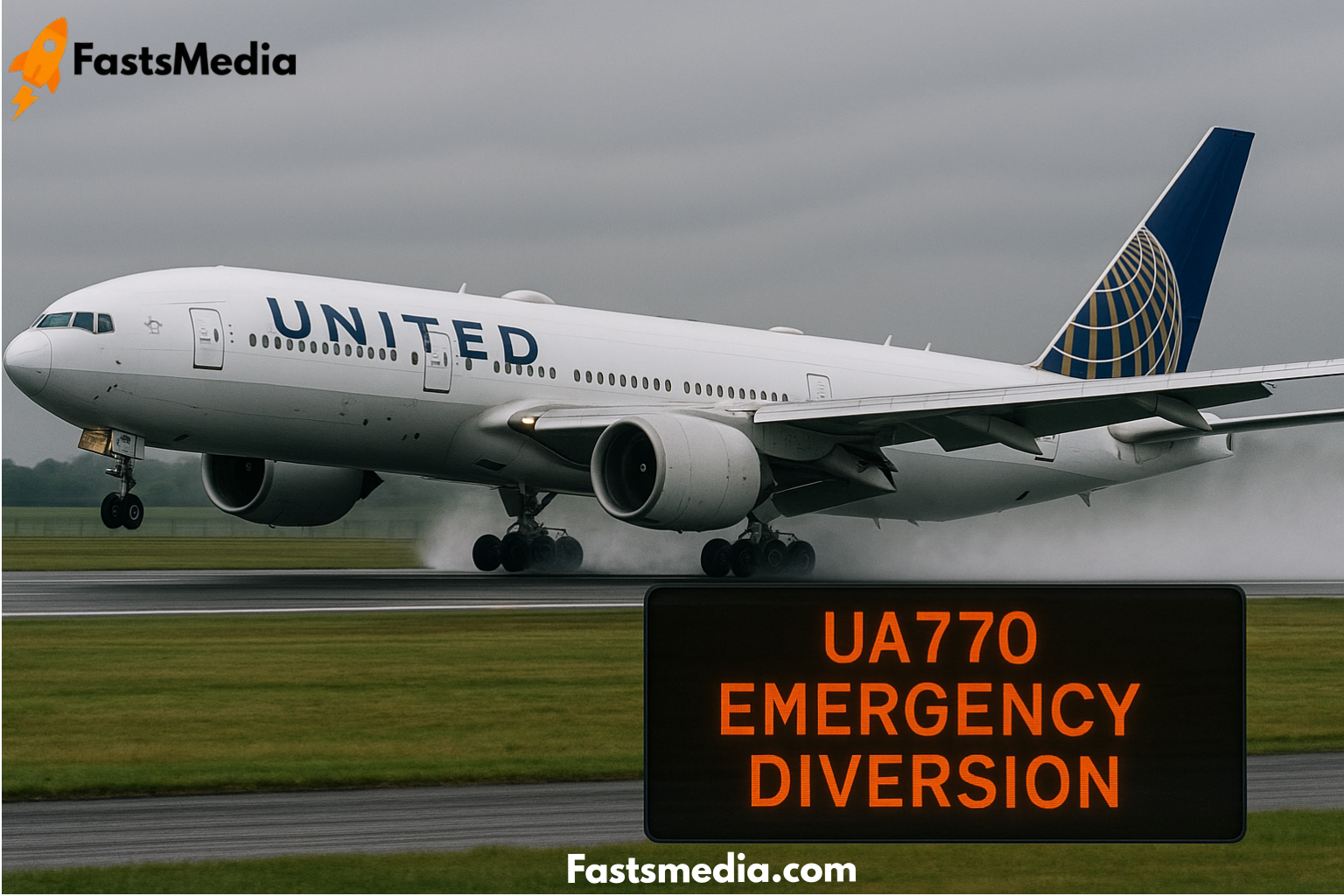Introduction
On a routine transatlantic journey, United Airlines Flight UA770 made headlines after an unexpected emergency diversion forced the aircraft to land at London Heathrow Airport. While the event may have caused anxiety among passengers, it ultimately demonstrated the effectiveness of modern aviation safety systems and the professionalism of flight crews under pressure.
Flight diversions are not uncommon in commercial aviation, but when they involve emergency declarations like Squawk 7700, they attract global attention. This article breaks down the UA770 emergency diversion, explaining what happened, why such procedures exist, and what passengers can learn from this event.
What Happened on United Airlines Flight UA770
Overview of the Incident
United Airlines Flight UA770 was operating a Boeing 787-9 Dreamliner en route from Barcelona (Spain) to Chicago O’Hare International Airport (USA). Roughly midway through the flight, while cruising over the Atlantic, the pilots detected a possible cabin pressurization issue — one of the most critical systems in high-altitude flight.
Following safety protocols, the pilots declared a general emergency by transmitting Squawk Code 7700, immediately alerting air traffic control and nearby aircraft. The decision was then made to divert to London Heathrow Airport, one of Europe’s best-equipped airports for emergency landings.
Safe Outcome
Despite the alarming declaration, the flight landed safely and without injury at Heathrow. The crew conducted a controlled descent, following all procedures to ensure passenger safety. No oxygen masks were deployed, and there were no reports of panic or injuries among passengers.
The aircraft was later inspected by ground engineers, and passengers were rebooked on alternate flights to their destinations — a testament to how structured and efficient aviation crisis management truly is.
Why Do Emergency Diversions Happen?
Understanding the Reasons
Emergency diversions, like that of UA770, can occur for several reasons. Airlines always prioritize safety, and any indication of risk prompts an immediate response. Common causes include:
- Mechanical or technical issues, such as engine or pressurization faults
- Medical emergencies, when passengers or crew need urgent attention
- Weather complications, including turbulence, storms, or visibility loss
- Security threats, such as unruly passengers or suspicious activity
In this case, the suspected pressurization issue was significant enough for the pilots to take no chances — a standard move in modern aviation.
The Role of Pilot Training
Pilots undergo rigorous simulator training to handle emergencies like this one. Each procedure, from emergency descent to communication with air traffic control (ATC), is rehearsed repeatedly. The quick and calm decision-making on UA770 illustrates how well-trained crews prevent potential disasters before they escalate.
How an Emergency Diversion Works: Step-by-Step Guide
When a flight like UA770 faces an emergency situation, strict international protocols come into play. Here’s a step-by-step breakdown of how such an event typically unfolds:
Step 1: Identifying the Problem
Pilots monitor cockpit instruments continuously. When an anomaly appears — for example, a change in cabin pressure or a system alert — they assess its severity using checklists designed by aircraft manufacturers.
Step 2: Declaring an Emergency
If the issue could affect safety, the pilots issue a “Mayday” call or set the Squawk 7700 transponder code. This gives them priority clearance from ATC, ensuring all nearby traffic gives way.
Step 3: Choosing a Diversion Airport
The nearest suitable airport is selected based on runway length, weather, maintenance facilities, and emergency response readiness. Heathrow, in UA770’s case, was an ideal choice.
Step 4: Preparing the Cabin
Cabin crew brief passengers, secure the cabin, and prepare for descent or landing. Communication is clear, calm, and procedural to reduce fear and confusion.
Step 5: Controlled Landing and Ground Response
Once on the ground, the aircraft is inspected by engineers, while passengers receive care, rebooking assistance, and information. Every step follows international aviation safety guidelines.
Pro Tip for Travelers: Always pay attention to the pre-flight safety briefing. Even though emergencies are rare, knowing what to do can make you calmer and safer during unexpected events.
Passenger Perspective: Inside the Cabin During the UA770 Diversion
The In-Flight Experience
Reports suggest that passengers aboard UA770 remained calm thanks to the professional communication from both the cockpit and cabin crew. No extreme turbulence or rapid descent occurred, and the aircraft’s systems functioned normally.
Many passengers only learned about the emergency after the plane landed, underscoring how efficiently crews manage information to maintain order. Cabin crew continued normal service until preparation for descent began — an important tactic for reducing anxiety.
Post-Landing Care
Once on the ground at Heathrow, passengers were assisted by United Airlines staff. Meals, accommodation, and rebookings were arranged, ensuring minimal disruption. The airline’s response reflected standard crisis management practices that prioritize comfort, clarity, and customer care.
Lessons in Aviation Safety and Preparedness
Aviation Safety Systems Work
The UA770 diversion demonstrates that even when things go wrong, aviation systems are designed to respond flawlessly. Pressurization alerts, automatic detection sensors, ATC coordination, and emergency services all function as part of a global safety net.
Why Flying Remains the Safest Way to Travel
Statistically, air travel remains the safest mode of transportation. Each aircraft is built with multiple redundant systems — meaning even if one fails, backups immediately take over. Events like this reinforce the notion that aviation safety is proactive, not reactive.
Trust the Process
When pilots divert or declare an emergency, it doesn’t mean something catastrophic is happening — it means safety is being prioritized before a situation can worsen. The calm professionalism displayed by UA770’s crew is proof of why air travel is so reliable.
Conclusion
The United Airlines Flight UA770 emergency diversion is a textbook example of aviation safety in action. From the pilots’ swift response to the coordinated landing at Heathrow and the care extended to passengers afterward, every step reflected precision, training, and composure.
While such incidents can be unnerving, they reaffirm one truth: airline crews and systems are built to protect lives first and foremost. What could have been a frightening event instead became a demonstration of calm professionalism and trust in procedure.
Whether you’re a frequent flyer or an occasional traveler, UA770’s safe outcome serves as a reminder that aviation is built on preparation, communication, and constant improvement — making it one of humanity’s greatest safety achievements.
FAQs
1. What caused the emergency diversion of United Airlines Flight UA770?
The pilots detected a possible cabin pressurization issue mid-flight and diverted to Heathrow as a precautionary measure.
2. What does “Squawk 7700” mean?
It’s an international transponder code that signals a general emergency, giving the aircraft priority handling from air traffic control.
3. Were there any injuries on UA770?
No injuries were reported. The aircraft landed safely, and passengers disembarked normally.
4. How often do emergency diversions happen?
Diversions occur occasionally but rarely due to serious emergencies. Most are precautionary, ensuring maximum passenger safety.
5. What should passengers do during a flight emergency?
Stay calm, follow crew instructions, keep seat belts fastened, and listen carefully to announcements. Cabin crews are fully trained for every scenario.

